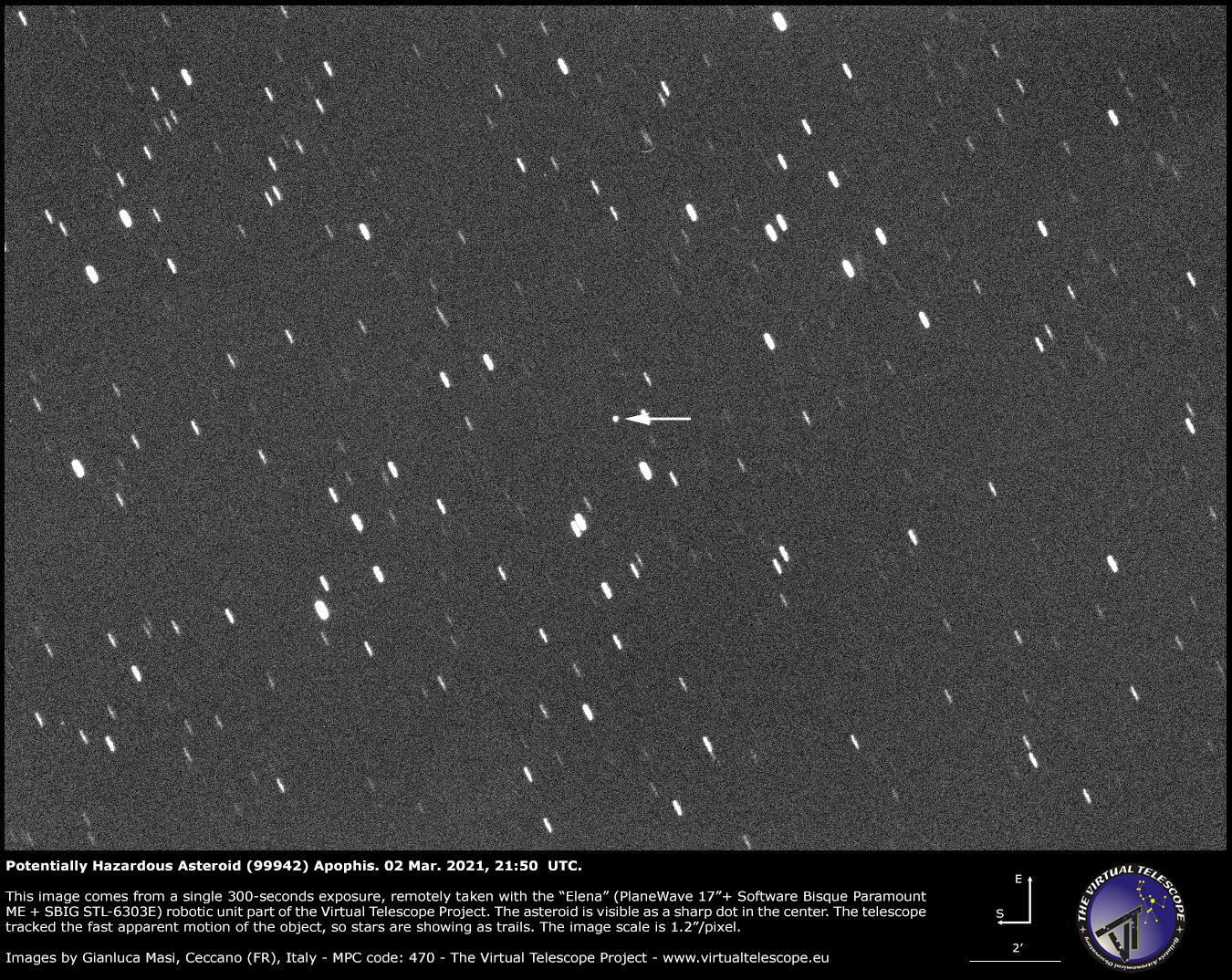Huge asteroid Apophis will safely fly past Earth tonight. Here's where to watch live online.

The big asteroid Apophis will pass safely by Earth tonight (March 5) and at least two astronomy broadcast services plan to showcase the flyby in live webcasts.
While personal telescopes smaller than 12 inches in diameter will strain to see Apophis Friday, both the Slooh online observatory and the Virtual Telescope Project plan separate webcasts for the event. The broadcasts will not only discuss the 2021 flyby, but will also drum up interest for a much closer pass in 2029, when Apophis will pass within 19,000 miles (31,000 kilometers) of Earth and be closer than some high-altitude satellites.
During tonight's much less dramatic flyby, Apophis will remain about 44 times as distant as the moon. At its closest point, the asteroid will be more than 10.2 million miles (16.4 million kilometers) from Earth.
The near-Earth asteroid is roughly 1,000 feet (300 meters) across and was discovered in 2004; while initial early estimates said there was a tiny chance of it crashing into Earth in 2029, that was ruled out after scientists refined its orbit, NASA said on its website.
Related: Scientists prepare for their last good look at asteroid Apophis before 2029 flyby
Slooh will broadcast live views of Apophis at its membership website Slooh.com starting at Friday at 8 p.m. EST (Saturday at 0100 GMT). The show will feature images of Apophis from Slooh's remotely operated observatories in Chile and the Canary Islands. A free 7-day trial is available here.
Members can also track the asteroid by themselves through the Canary Islands and Chile telescopes a few hours before the broadcast, Slooh's chief astronomical officer Paul Cox told Space.com.
Get the Space.com Newsletter
Breaking space news, the latest updates on rocket launches, skywatching events and more!
"We'll be tracking Apophis most of the night," Cox said in an e-mail. "I'll be hosting the live star party, and our guests are Bob Berman and Dr. Mike Shaw. We'll be discussing Apophis, the risks near-Earth objects pose to Earth, our historic coverage of Apophis, and Slooh's legacy tracking these near-Earth asteroid passes since 2008."
Slooh also plans to discuss an upcoming member course on tracking near-Earth objects and making submissions to the International Astronomical Union's Minor Planet Center, which is responsible for designating small solar system objects, Cox said.
The feed from the Virtual Telescope Project, with robotic telescope observation capabilities situated near Rome, will start on Friday at 7 p.m. EST (Saturday, March 6, 0000 GMT) at this website.
"By far the most famous potentially hazardous asteroid, 99942 Apophis will have a relatively close approach to Earth," founder Gianluca Masi said in a statement on the broadcast webpage. "While waiting for its record-setting 2029 fly-by, we will share this upcoming opportunity with you, so join us and see it live from the comfort of your home."
Friday's flyby will see Apophis will get as close as 0.11 astronomical units to Earth, or roughly 44 times the distance between the Earth and the moon. While Apophis poses no immediate threat to Earth, NASA and its Planetary Defense Coordination Office do examine the sky regularly using a network of partner telescopes. NASA has a mandate from U.S. Congress to search out potentially hazardous asteroids and so far, the agency and its partners have found nothing imminently worrying to residents of Earth.
Follow Elizabeth Howell on Twitter @howellspace. Follow us on Twitter @Spacedotcom and on Facebook.
Join our Space Forums to keep talking space on the latest missions, night sky and more! And if you have a news tip, correction or comment, let us know at: community@space.com.

Elizabeth Howell (she/her), Ph.D., was a staff writer in the spaceflight channel between 2022 and 2024 specializing in Canadian space news. She was contributing writer for Space.com for 10 years from 2012 to 2024. Elizabeth's reporting includes multiple exclusives with the White House, leading world coverage about a lost-and-found space tomato on the International Space Station, witnessing five human spaceflight launches on two continents, flying parabolic, working inside a spacesuit, and participating in a simulated Mars mission. Her latest book, "Why Am I Taller?" (ECW Press, 2022) is co-written with astronaut Dave Williams.









